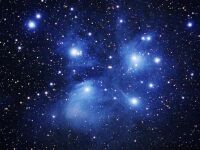Open clusters
An open cluster is an irregular group of star having the same recent origin. It is mainly made up of young and hot stars having a common evolution and mutually bound by gravitation. It contains dozen to hundreds of stars and its diameter lies between 5 and 50 light-years. There are more than 1000 open clusters currently indexed in the Milky Way.
The open clusters' classification, according to R.J. Trumpler, uses a classification on three levels indicating the density, the light intensity difference and the number of stars.

M45 - Pleiades
Globular clusters
A globular cluster is a spherical group of stars that have the same origin and are generally very old. Such a cluster contains from tens of thousands to hundreds of thousands of stars, and for some reach the million. It forms a regular sphere with the density of stars increasing towards the center. Its diameter is between 50 and 300 light-years. Globular clusters are among the oldest structures of the Milky Way (our galaxy) and 147 are currently indexed.
Globular cluster classification, done according to H. Shapley and H.B. Sawyer, uses a Roman numeral indicating the stars' density.

M71
Other deep sky objects: